Corporate Social Responsibility and Crisis Management
VerifiedAdded on 2020/01/21
|16
|3973
|118
AI Summary
This assignment analyzes the relationship between financial crises, corporate social responsibility (CSR), and crisis management. It argues that the 2008 financial crisis highlighted the limitations of organizations solely focused on self-interest, emphasizing the need for greater transparency, accountability, and sustainable practices within CSR frameworks. The document explores how organizations can learn from this crisis to develop more robust crisis management strategies and build trust in an increasingly unpredictable global environment.
Contribute Materials
Your contribution can guide someone’s learning journey. Share your
documents today.
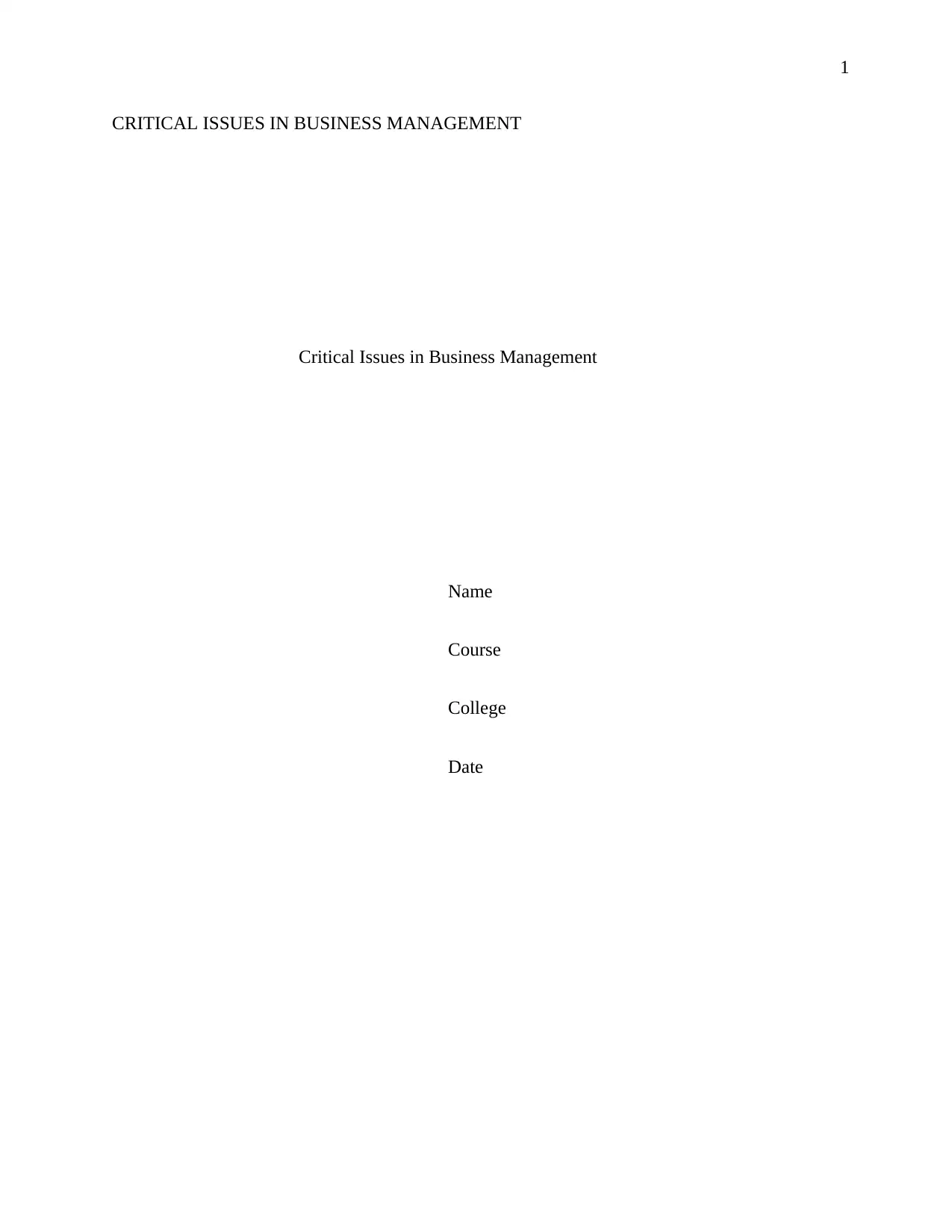
1
CRITICAL ISSUES IN BUSINESS MANAGEMENT
Critical Issues in Business Management
Name
Course
College
Date
CRITICAL ISSUES IN BUSINESS MANAGEMENT
Critical Issues in Business Management
Name
Course
College
Date
Secure Best Marks with AI Grader
Need help grading? Try our AI Grader for instant feedback on your assignments.
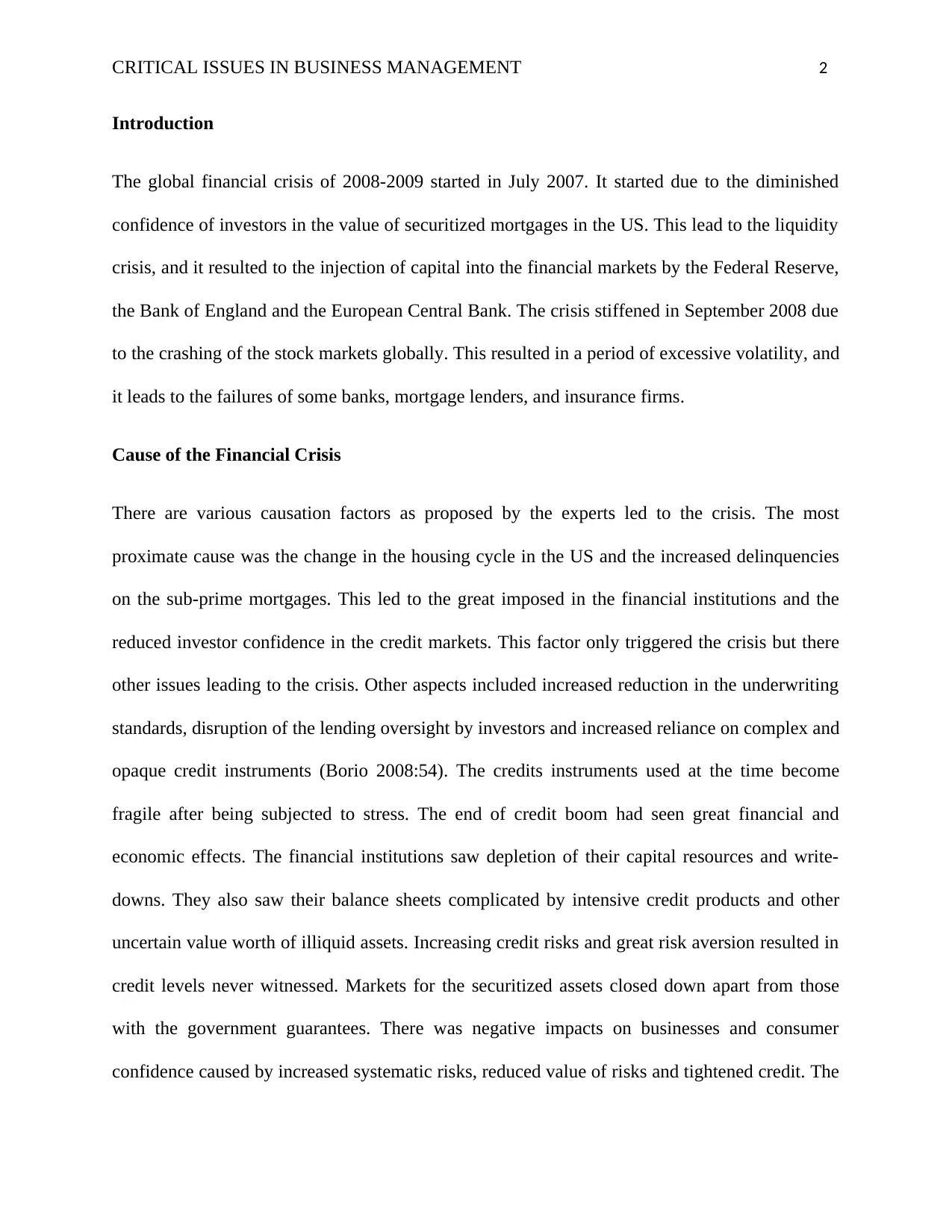
CRITICAL ISSUES IN BUSINESS MANAGEMENT 2
Introduction
The global financial crisis of 2008-2009 started in July 2007. It started due to the diminished
confidence of investors in the value of securitized mortgages in the US. This lead to the liquidity
crisis, and it resulted to the injection of capital into the financial markets by the Federal Reserve,
the Bank of England and the European Central Bank. The crisis stiffened in September 2008 due
to the crashing of the stock markets globally. This resulted in a period of excessive volatility, and
it leads to the failures of some banks, mortgage lenders, and insurance firms.
Cause of the Financial Crisis
There are various causation factors as proposed by the experts led to the crisis. The most
proximate cause was the change in the housing cycle in the US and the increased delinquencies
on the sub-prime mortgages. This led to the great imposed in the financial institutions and the
reduced investor confidence in the credit markets. This factor only triggered the crisis but there
other issues leading to the crisis. Other aspects included increased reduction in the underwriting
standards, disruption of the lending oversight by investors and increased reliance on complex and
opaque credit instruments (Borio 2008:54). The credits instruments used at the time become
fragile after being subjected to stress. The end of credit boom had seen great financial and
economic effects. The financial institutions saw depletion of their capital resources and write-
downs. They also saw their balance sheets complicated by intensive credit products and other
uncertain value worth of illiquid assets. Increasing credit risks and great risk aversion resulted in
credit levels never witnessed. Markets for the securitized assets closed down apart from those
with the government guarantees. There was negative impacts on businesses and consumer
confidence caused by increased systematic risks, reduced value of risks and tightened credit. The
Introduction
The global financial crisis of 2008-2009 started in July 2007. It started due to the diminished
confidence of investors in the value of securitized mortgages in the US. This lead to the liquidity
crisis, and it resulted to the injection of capital into the financial markets by the Federal Reserve,
the Bank of England and the European Central Bank. The crisis stiffened in September 2008 due
to the crashing of the stock markets globally. This resulted in a period of excessive volatility, and
it leads to the failures of some banks, mortgage lenders, and insurance firms.
Cause of the Financial Crisis
There are various causation factors as proposed by the experts led to the crisis. The most
proximate cause was the change in the housing cycle in the US and the increased delinquencies
on the sub-prime mortgages. This led to the great imposed in the financial institutions and the
reduced investor confidence in the credit markets. This factor only triggered the crisis but there
other issues leading to the crisis. Other aspects included increased reduction in the underwriting
standards, disruption of the lending oversight by investors and increased reliance on complex and
opaque credit instruments (Borio 2008:54). The credits instruments used at the time become
fragile after being subjected to stress. The end of credit boom had seen great financial and
economic effects. The financial institutions saw depletion of their capital resources and write-
downs. They also saw their balance sheets complicated by intensive credit products and other
uncertain value worth of illiquid assets. Increasing credit risks and great risk aversion resulted in
credit levels never witnessed. Markets for the securitized assets closed down apart from those
with the government guarantees. There was negative impacts on businesses and consumer
confidence caused by increased systematic risks, reduced value of risks and tightened credit. The
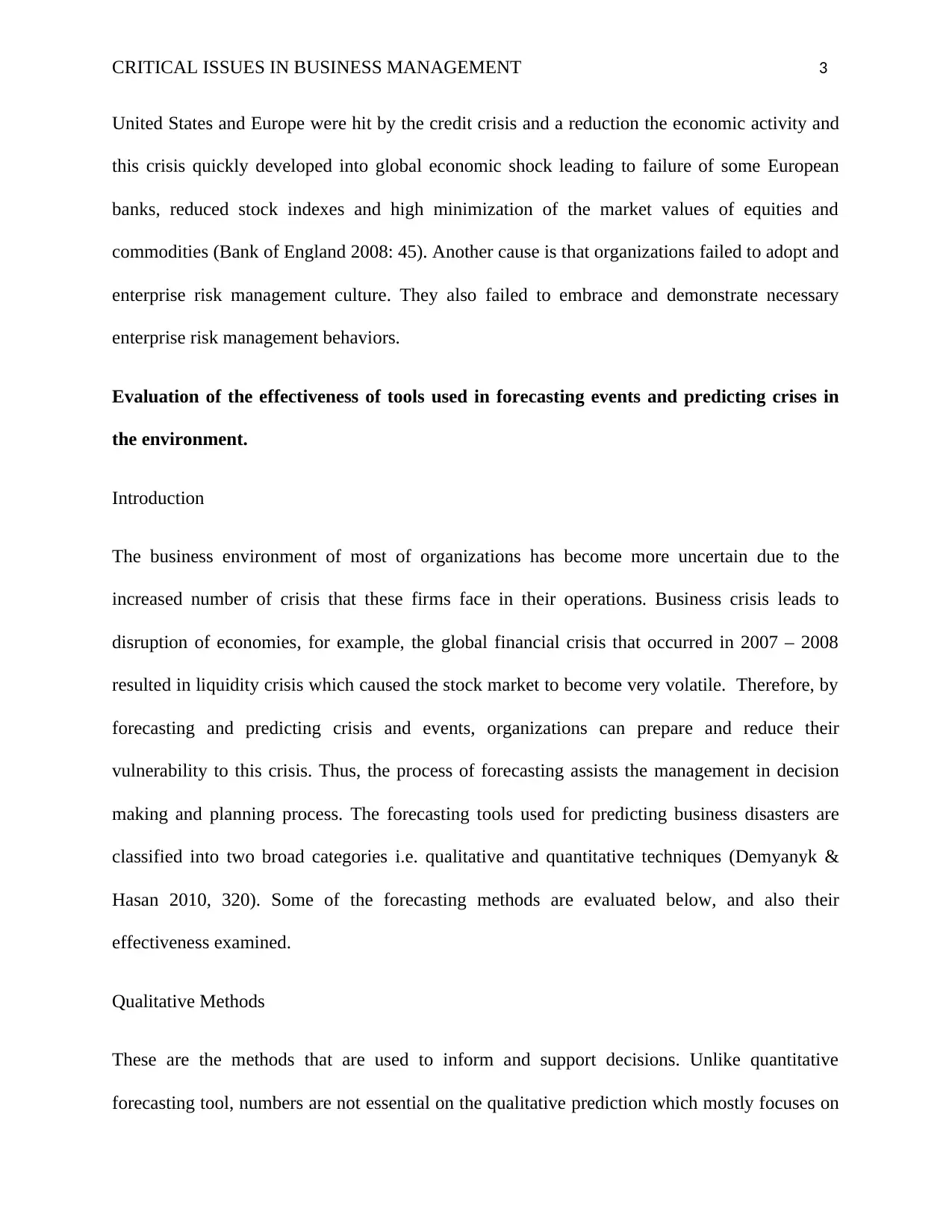
CRITICAL ISSUES IN BUSINESS MANAGEMENT 3
United States and Europe were hit by the credit crisis and a reduction the economic activity and
this crisis quickly developed into global economic shock leading to failure of some European
banks, reduced stock indexes and high minimization of the market values of equities and
commodities (Bank of England 2008: 45). Another cause is that organizations failed to adopt and
enterprise risk management culture. They also failed to embrace and demonstrate necessary
enterprise risk management behaviors.
Evaluation of the effectiveness of tools used in forecasting events and predicting crises in
the environment.
Introduction
The business environment of most of organizations has become more uncertain due to the
increased number of crisis that these firms face in their operations. Business crisis leads to
disruption of economies, for example, the global financial crisis that occurred in 2007 – 2008
resulted in liquidity crisis which caused the stock market to become very volatile. Therefore, by
forecasting and predicting crisis and events, organizations can prepare and reduce their
vulnerability to this crisis. Thus, the process of forecasting assists the management in decision
making and planning process. The forecasting tools used for predicting business disasters are
classified into two broad categories i.e. qualitative and quantitative techniques (Demyanyk &
Hasan 2010, 320). Some of the forecasting methods are evaluated below, and also their
effectiveness examined.
Qualitative Methods
These are the methods that are used to inform and support decisions. Unlike quantitative
forecasting tool, numbers are not essential on the qualitative prediction which mostly focuses on
United States and Europe were hit by the credit crisis and a reduction the economic activity and
this crisis quickly developed into global economic shock leading to failure of some European
banks, reduced stock indexes and high minimization of the market values of equities and
commodities (Bank of England 2008: 45). Another cause is that organizations failed to adopt and
enterprise risk management culture. They also failed to embrace and demonstrate necessary
enterprise risk management behaviors.
Evaluation of the effectiveness of tools used in forecasting events and predicting crises in
the environment.
Introduction
The business environment of most of organizations has become more uncertain due to the
increased number of crisis that these firms face in their operations. Business crisis leads to
disruption of economies, for example, the global financial crisis that occurred in 2007 – 2008
resulted in liquidity crisis which caused the stock market to become very volatile. Therefore, by
forecasting and predicting crisis and events, organizations can prepare and reduce their
vulnerability to this crisis. Thus, the process of forecasting assists the management in decision
making and planning process. The forecasting tools used for predicting business disasters are
classified into two broad categories i.e. qualitative and quantitative techniques (Demyanyk &
Hasan 2010, 320). Some of the forecasting methods are evaluated below, and also their
effectiveness examined.
Qualitative Methods
These are the methods that are used to inform and support decisions. Unlike quantitative
forecasting tool, numbers are not essential on the qualitative prediction which mostly focuses on
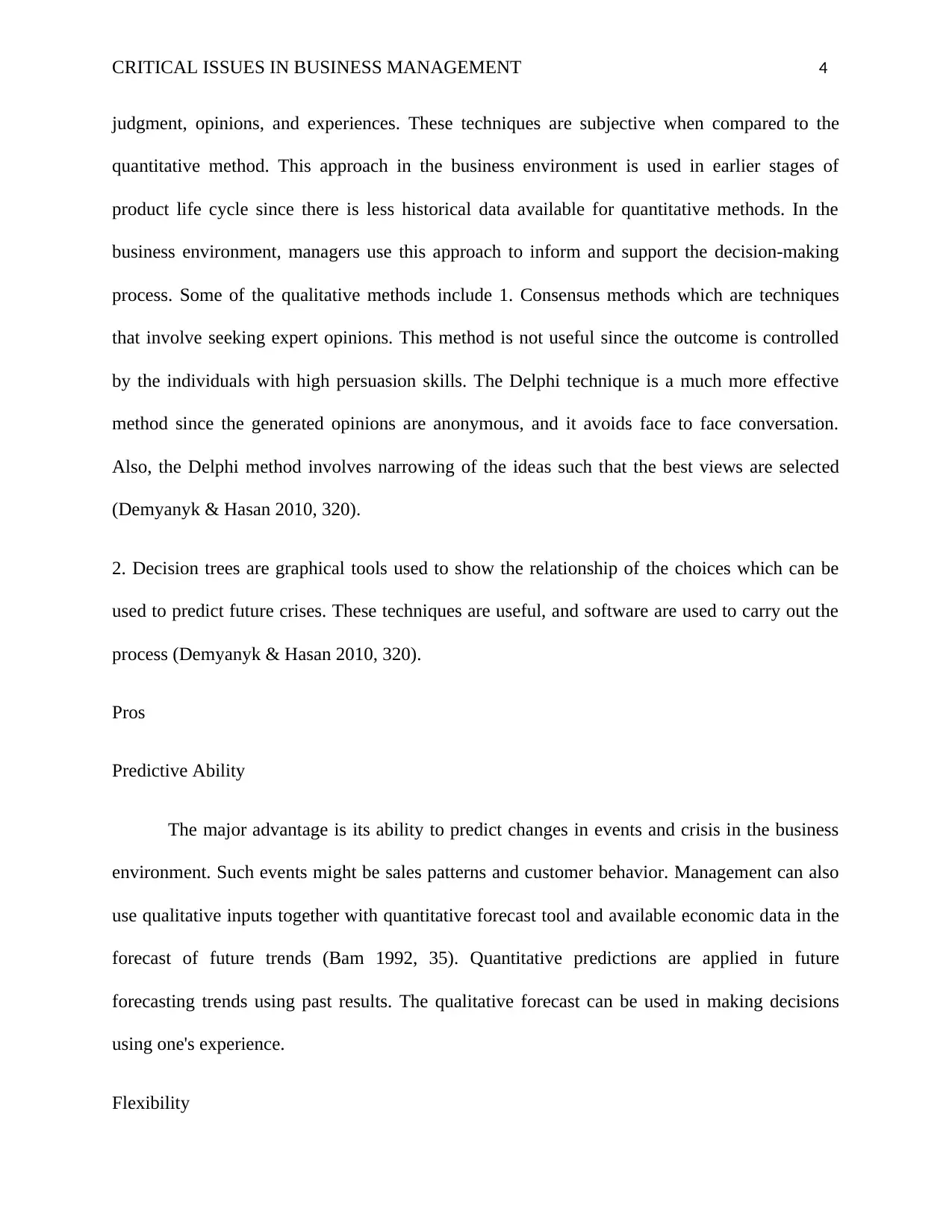
CRITICAL ISSUES IN BUSINESS MANAGEMENT 4
judgment, opinions, and experiences. These techniques are subjective when compared to the
quantitative method. This approach in the business environment is used in earlier stages of
product life cycle since there is less historical data available for quantitative methods. In the
business environment, managers use this approach to inform and support the decision-making
process. Some of the qualitative methods include 1. Consensus methods which are techniques
that involve seeking expert opinions. This method is not useful since the outcome is controlled
by the individuals with high persuasion skills. The Delphi technique is a much more effective
method since the generated opinions are anonymous, and it avoids face to face conversation.
Also, the Delphi method involves narrowing of the ideas such that the best views are selected
(Demyanyk & Hasan 2010, 320).
2. Decision trees are graphical tools used to show the relationship of the choices which can be
used to predict future crises. These techniques are useful, and software are used to carry out the
process (Demyanyk & Hasan 2010, 320).
Pros
Predictive Ability
The major advantage is its ability to predict changes in events and crisis in the business
environment. Such events might be sales patterns and customer behavior. Management can also
use qualitative inputs together with quantitative forecast tool and available economic data in the
forecast of future trends (Bam 1992, 35). Quantitative predictions are applied in future
forecasting trends using past results. The qualitative forecast can be used in making decisions
using one's experience.
Flexibility
judgment, opinions, and experiences. These techniques are subjective when compared to the
quantitative method. This approach in the business environment is used in earlier stages of
product life cycle since there is less historical data available for quantitative methods. In the
business environment, managers use this approach to inform and support the decision-making
process. Some of the qualitative methods include 1. Consensus methods which are techniques
that involve seeking expert opinions. This method is not useful since the outcome is controlled
by the individuals with high persuasion skills. The Delphi technique is a much more effective
method since the generated opinions are anonymous, and it avoids face to face conversation.
Also, the Delphi method involves narrowing of the ideas such that the best views are selected
(Demyanyk & Hasan 2010, 320).
2. Decision trees are graphical tools used to show the relationship of the choices which can be
used to predict future crises. These techniques are useful, and software are used to carry out the
process (Demyanyk & Hasan 2010, 320).
Pros
Predictive Ability
The major advantage is its ability to predict changes in events and crisis in the business
environment. Such events might be sales patterns and customer behavior. Management can also
use qualitative inputs together with quantitative forecast tool and available economic data in the
forecast of future trends (Bam 1992, 35). Quantitative predictions are applied in future
forecasting trends using past results. The qualitative forecast can be used in making decisions
using one's experience.
Flexibility
Secure Best Marks with AI Grader
Need help grading? Try our AI Grader for instant feedback on your assignments.
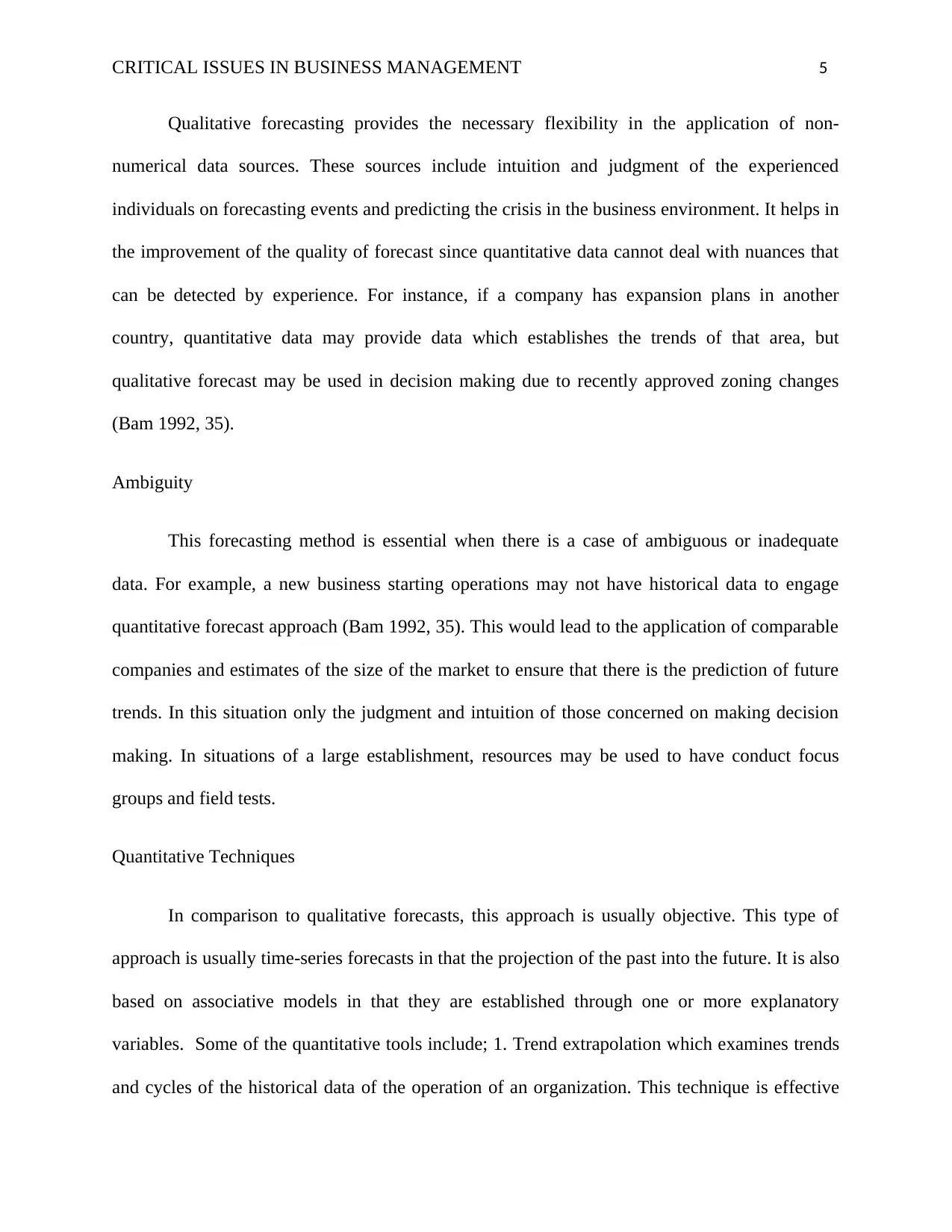
CRITICAL ISSUES IN BUSINESS MANAGEMENT 5
Qualitative forecasting provides the necessary flexibility in the application of non-
numerical data sources. These sources include intuition and judgment of the experienced
individuals on forecasting events and predicting the crisis in the business environment. It helps in
the improvement of the quality of forecast since quantitative data cannot deal with nuances that
can be detected by experience. For instance, if a company has expansion plans in another
country, quantitative data may provide data which establishes the trends of that area, but
qualitative forecast may be used in decision making due to recently approved zoning changes
(Bam 1992, 35).
Ambiguity
This forecasting method is essential when there is a case of ambiguous or inadequate
data. For example, a new business starting operations may not have historical data to engage
quantitative forecast approach (Bam 1992, 35). This would lead to the application of comparable
companies and estimates of the size of the market to ensure that there is the prediction of future
trends. In this situation only the judgment and intuition of those concerned on making decision
making. In situations of a large establishment, resources may be used to have conduct focus
groups and field tests.
Quantitative Techniques
In comparison to qualitative forecasts, this approach is usually objective. This type of
approach is usually time-series forecasts in that the projection of the past into the future. It is also
based on associative models in that they are established through one or more explanatory
variables. Some of the quantitative tools include; 1. Trend extrapolation which examines trends
and cycles of the historical data of the operation of an organization. This technique is effective
Qualitative forecasting provides the necessary flexibility in the application of non-
numerical data sources. These sources include intuition and judgment of the experienced
individuals on forecasting events and predicting the crisis in the business environment. It helps in
the improvement of the quality of forecast since quantitative data cannot deal with nuances that
can be detected by experience. For instance, if a company has expansion plans in another
country, quantitative data may provide data which establishes the trends of that area, but
qualitative forecast may be used in decision making due to recently approved zoning changes
(Bam 1992, 35).
Ambiguity
This forecasting method is essential when there is a case of ambiguous or inadequate
data. For example, a new business starting operations may not have historical data to engage
quantitative forecast approach (Bam 1992, 35). This would lead to the application of comparable
companies and estimates of the size of the market to ensure that there is the prediction of future
trends. In this situation only the judgment and intuition of those concerned on making decision
making. In situations of a large establishment, resources may be used to have conduct focus
groups and field tests.
Quantitative Techniques
In comparison to qualitative forecasts, this approach is usually objective. This type of
approach is usually time-series forecasts in that the projection of the past into the future. It is also
based on associative models in that they are established through one or more explanatory
variables. Some of the quantitative tools include; 1. Trend extrapolation which examines trends
and cycles of the historical data of the operation of an organization. This technique is effective
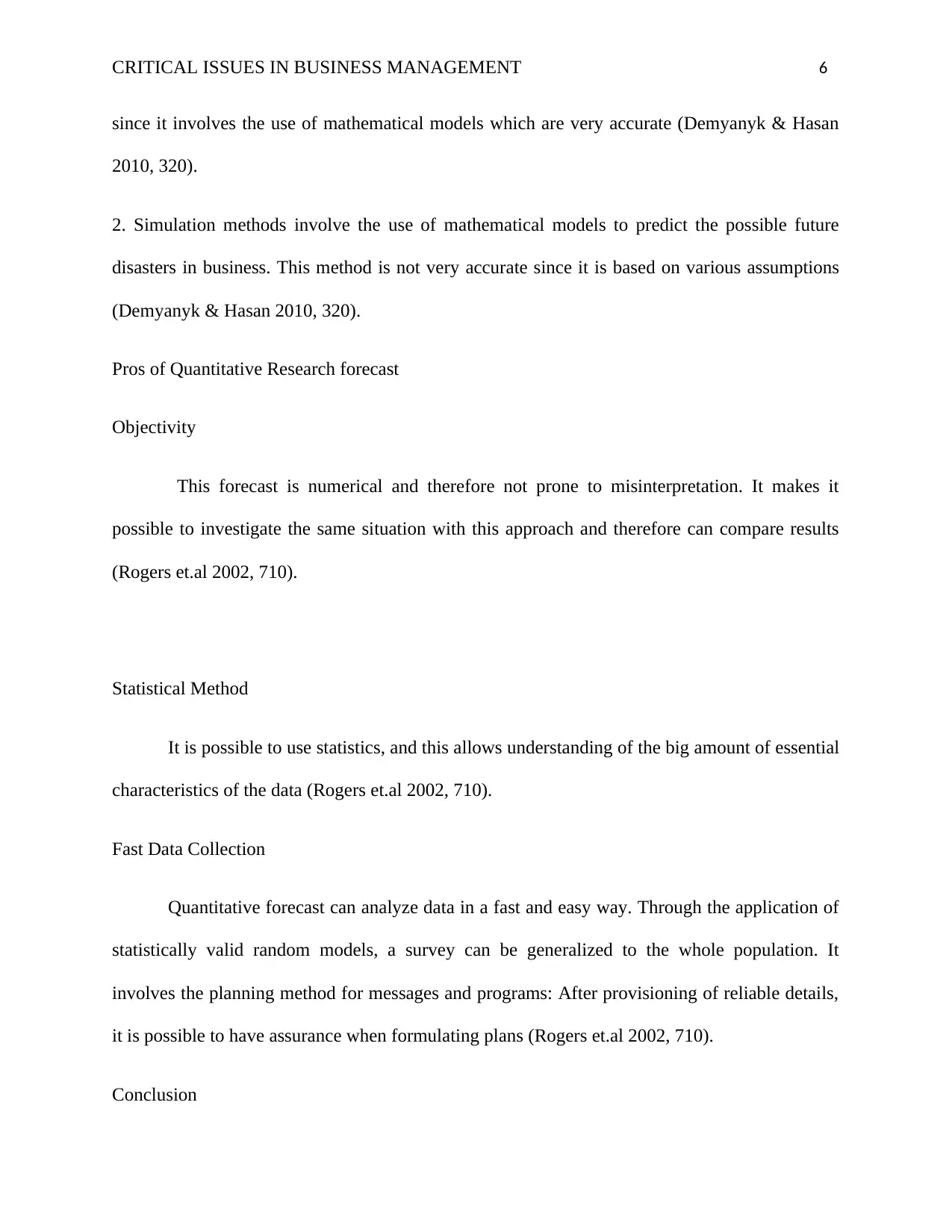
CRITICAL ISSUES IN BUSINESS MANAGEMENT 6
since it involves the use of mathematical models which are very accurate (Demyanyk & Hasan
2010, 320).
2. Simulation methods involve the use of mathematical models to predict the possible future
disasters in business. This method is not very accurate since it is based on various assumptions
(Demyanyk & Hasan 2010, 320).
Pros of Quantitative Research forecast
Objectivity
This forecast is numerical and therefore not prone to misinterpretation. It makes it
possible to investigate the same situation with this approach and therefore can compare results
(Rogers et.al 2002, 710).
Statistical Method
It is possible to use statistics, and this allows understanding of the big amount of essential
characteristics of the data (Rogers et.al 2002, 710).
Fast Data Collection
Quantitative forecast can analyze data in a fast and easy way. Through the application of
statistically valid random models, a survey can be generalized to the whole population. It
involves the planning method for messages and programs: After provisioning of reliable details,
it is possible to have assurance when formulating plans (Rogers et.al 2002, 710).
Conclusion
since it involves the use of mathematical models which are very accurate (Demyanyk & Hasan
2010, 320).
2. Simulation methods involve the use of mathematical models to predict the possible future
disasters in business. This method is not very accurate since it is based on various assumptions
(Demyanyk & Hasan 2010, 320).
Pros of Quantitative Research forecast
Objectivity
This forecast is numerical and therefore not prone to misinterpretation. It makes it
possible to investigate the same situation with this approach and therefore can compare results
(Rogers et.al 2002, 710).
Statistical Method
It is possible to use statistics, and this allows understanding of the big amount of essential
characteristics of the data (Rogers et.al 2002, 710).
Fast Data Collection
Quantitative forecast can analyze data in a fast and easy way. Through the application of
statistically valid random models, a survey can be generalized to the whole population. It
involves the planning method for messages and programs: After provisioning of reliable details,
it is possible to have assurance when formulating plans (Rogers et.al 2002, 710).
Conclusion
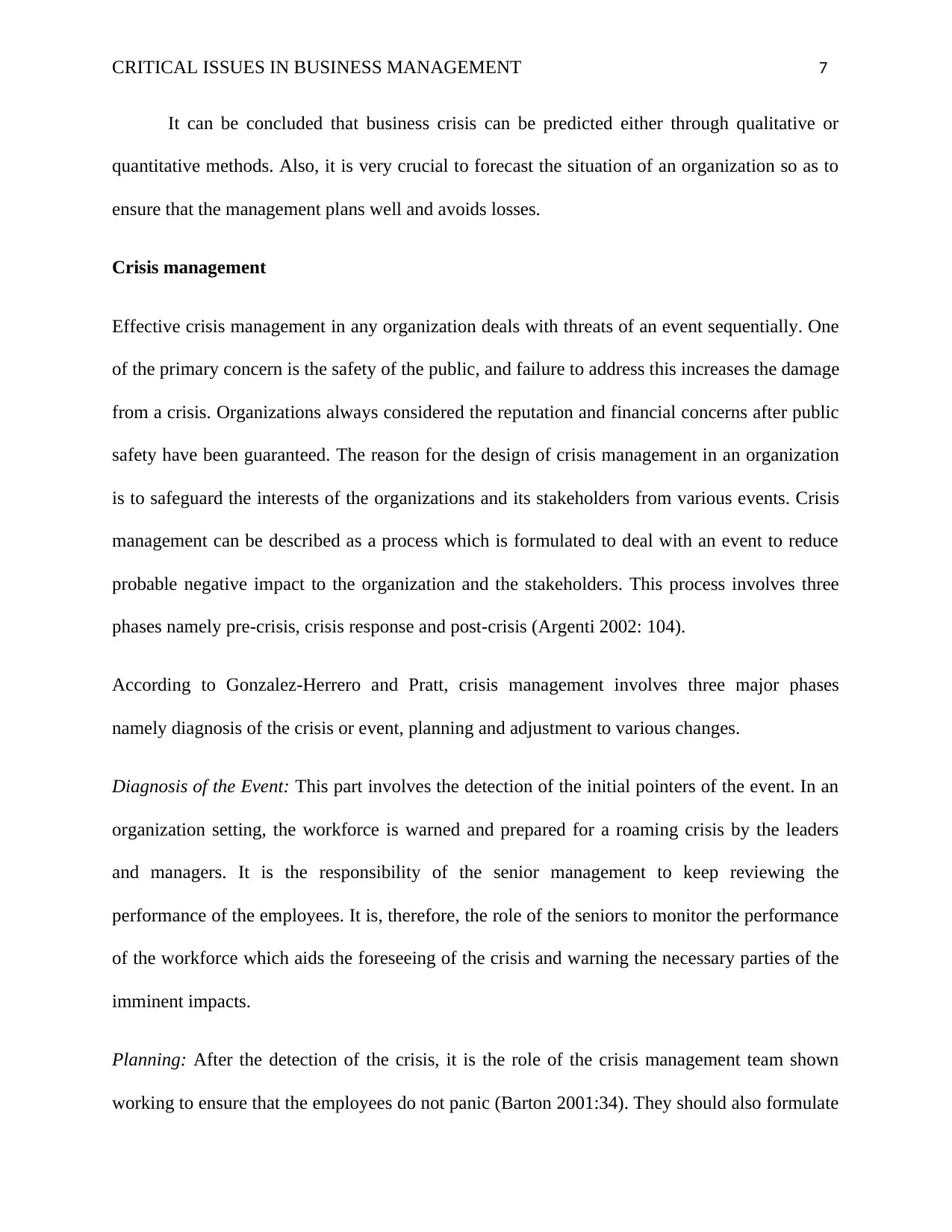
CRITICAL ISSUES IN BUSINESS MANAGEMENT 7
It can be concluded that business crisis can be predicted either through qualitative or
quantitative methods. Also, it is very crucial to forecast the situation of an organization so as to
ensure that the management plans well and avoids losses.
Crisis management
Effective crisis management in any organization deals with threats of an event sequentially. One
of the primary concern is the safety of the public, and failure to address this increases the damage
from a crisis. Organizations always considered the reputation and financial concerns after public
safety have been guaranteed. The reason for the design of crisis management in an organization
is to safeguard the interests of the organizations and its stakeholders from various events. Crisis
management can be described as a process which is formulated to deal with an event to reduce
probable negative impact to the organization and the stakeholders. This process involves three
phases namely pre-crisis, crisis response and post-crisis (Argenti 2002: 104).
According to Gonzalez-Herrero and Pratt, crisis management involves three major phases
namely diagnosis of the crisis or event, planning and adjustment to various changes.
Diagnosis of the Event: This part involves the detection of the initial pointers of the event. In an
organization setting, the workforce is warned and prepared for a roaming crisis by the leaders
and managers. It is the responsibility of the senior management to keep reviewing the
performance of the employees. It is, therefore, the role of the seniors to monitor the performance
of the workforce which aids the foreseeing of the crisis and warning the necessary parties of the
imminent impacts.
Planning: After the detection of the crisis, it is the role of the crisis management team shown
working to ensure that the employees do not panic (Barton 2001:34). They should also formulate
It can be concluded that business crisis can be predicted either through qualitative or
quantitative methods. Also, it is very crucial to forecast the situation of an organization so as to
ensure that the management plans well and avoids losses.
Crisis management
Effective crisis management in any organization deals with threats of an event sequentially. One
of the primary concern is the safety of the public, and failure to address this increases the damage
from a crisis. Organizations always considered the reputation and financial concerns after public
safety have been guaranteed. The reason for the design of crisis management in an organization
is to safeguard the interests of the organizations and its stakeholders from various events. Crisis
management can be described as a process which is formulated to deal with an event to reduce
probable negative impact to the organization and the stakeholders. This process involves three
phases namely pre-crisis, crisis response and post-crisis (Argenti 2002: 104).
According to Gonzalez-Herrero and Pratt, crisis management involves three major phases
namely diagnosis of the crisis or event, planning and adjustment to various changes.
Diagnosis of the Event: This part involves the detection of the initial pointers of the event. In an
organization setting, the workforce is warned and prepared for a roaming crisis by the leaders
and managers. It is the responsibility of the senior management to keep reviewing the
performance of the employees. It is, therefore, the role of the seniors to monitor the performance
of the workforce which aids the foreseeing of the crisis and warning the necessary parties of the
imminent impacts.
Planning: After the detection of the crisis, it is the role of the crisis management team shown
working to ensure that the employees do not panic (Barton 2001:34). They should also formulate
Paraphrase This Document
Need a fresh take? Get an instant paraphrase of this document with our AI Paraphraser
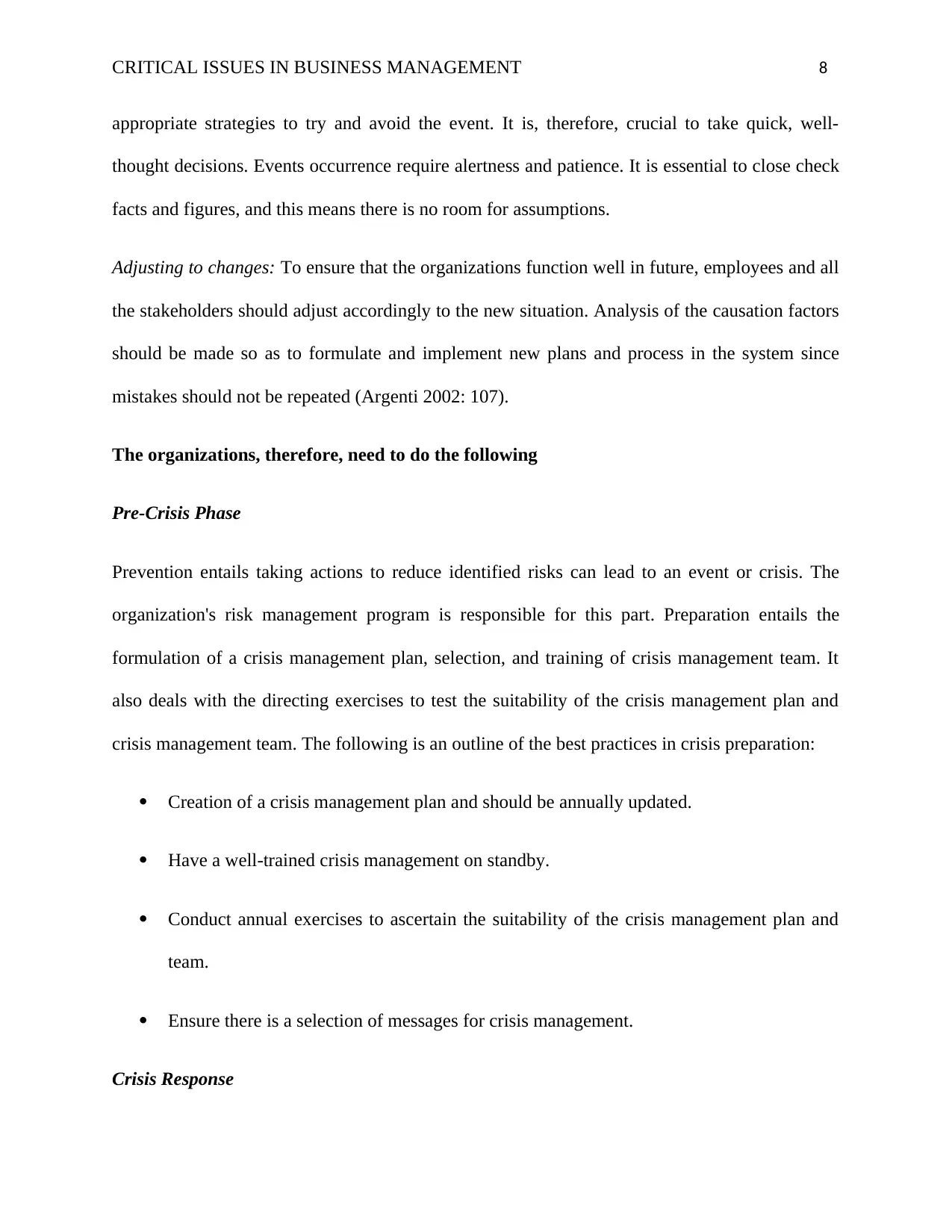
CRITICAL ISSUES IN BUSINESS MANAGEMENT 8
appropriate strategies to try and avoid the event. It is, therefore, crucial to take quick, well-
thought decisions. Events occurrence require alertness and patience. It is essential to close check
facts and figures, and this means there is no room for assumptions.
Adjusting to changes: To ensure that the organizations function well in future, employees and all
the stakeholders should adjust accordingly to the new situation. Analysis of the causation factors
should be made so as to formulate and implement new plans and process in the system since
mistakes should not be repeated (Argenti 2002: 107).
The organizations, therefore, need to do the following
Pre-Crisis Phase
Prevention entails taking actions to reduce identified risks can lead to an event or crisis. The
organization's risk management program is responsible for this part. Preparation entails the
formulation of a crisis management plan, selection, and training of crisis management team. It
also deals with the directing exercises to test the suitability of the crisis management plan and
crisis management team. The following is an outline of the best practices in crisis preparation:
Creation of a crisis management plan and should be annually updated.
Have a well-trained crisis management on standby.
Conduct annual exercises to ascertain the suitability of the crisis management plan and
team.
Ensure there is a selection of messages for crisis management.
Crisis Response
appropriate strategies to try and avoid the event. It is, therefore, crucial to take quick, well-
thought decisions. Events occurrence require alertness and patience. It is essential to close check
facts and figures, and this means there is no room for assumptions.
Adjusting to changes: To ensure that the organizations function well in future, employees and all
the stakeholders should adjust accordingly to the new situation. Analysis of the causation factors
should be made so as to formulate and implement new plans and process in the system since
mistakes should not be repeated (Argenti 2002: 107).
The organizations, therefore, need to do the following
Pre-Crisis Phase
Prevention entails taking actions to reduce identified risks can lead to an event or crisis. The
organization's risk management program is responsible for this part. Preparation entails the
formulation of a crisis management plan, selection, and training of crisis management team. It
also deals with the directing exercises to test the suitability of the crisis management plan and
crisis management team. The following is an outline of the best practices in crisis preparation:
Creation of a crisis management plan and should be annually updated.
Have a well-trained crisis management on standby.
Conduct annual exercises to ascertain the suitability of the crisis management plan and
team.
Ensure there is a selection of messages for crisis management.
Crisis Response
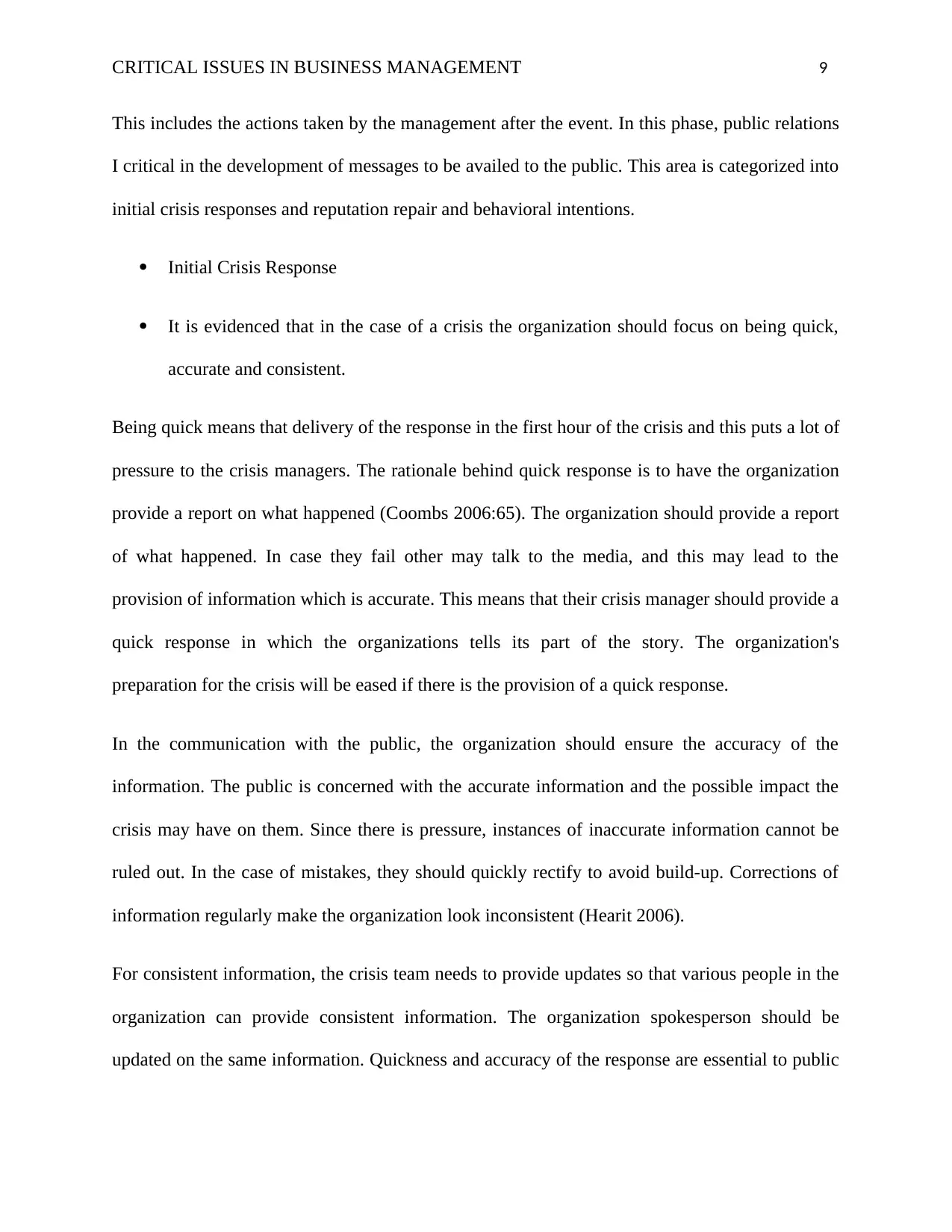
CRITICAL ISSUES IN BUSINESS MANAGEMENT 9
This includes the actions taken by the management after the event. In this phase, public relations
I critical in the development of messages to be availed to the public. This area is categorized into
initial crisis responses and reputation repair and behavioral intentions.
Initial Crisis Response
It is evidenced that in the case of a crisis the organization should focus on being quick,
accurate and consistent.
Being quick means that delivery of the response in the first hour of the crisis and this puts a lot of
pressure to the crisis managers. The rationale behind quick response is to have the organization
provide a report on what happened (Coombs 2006:65). The organization should provide a report
of what happened. In case they fail other may talk to the media, and this may lead to the
provision of information which is accurate. This means that their crisis manager should provide a
quick response in which the organizations tells its part of the story. The organization's
preparation for the crisis will be eased if there is the provision of a quick response.
In the communication with the public, the organization should ensure the accuracy of the
information. The public is concerned with the accurate information and the possible impact the
crisis may have on them. Since there is pressure, instances of inaccurate information cannot be
ruled out. In the case of mistakes, they should quickly rectify to avoid build-up. Corrections of
information regularly make the organization look inconsistent (Hearit 2006).
For consistent information, the crisis team needs to provide updates so that various people in the
organization can provide consistent information. The organization spokesperson should be
updated on the same information. Quickness and accuracy of the response are essential to public
This includes the actions taken by the management after the event. In this phase, public relations
I critical in the development of messages to be availed to the public. This area is categorized into
initial crisis responses and reputation repair and behavioral intentions.
Initial Crisis Response
It is evidenced that in the case of a crisis the organization should focus on being quick,
accurate and consistent.
Being quick means that delivery of the response in the first hour of the crisis and this puts a lot of
pressure to the crisis managers. The rationale behind quick response is to have the organization
provide a report on what happened (Coombs 2006:65). The organization should provide a report
of what happened. In case they fail other may talk to the media, and this may lead to the
provision of information which is accurate. This means that their crisis manager should provide a
quick response in which the organizations tells its part of the story. The organization's
preparation for the crisis will be eased if there is the provision of a quick response.
In the communication with the public, the organization should ensure the accuracy of the
information. The public is concerned with the accurate information and the possible impact the
crisis may have on them. Since there is pressure, instances of inaccurate information cannot be
ruled out. In the case of mistakes, they should quickly rectify to avoid build-up. Corrections of
information regularly make the organization look inconsistent (Hearit 2006).
For consistent information, the crisis team needs to provide updates so that various people in the
organization can provide consistent information. The organization spokesperson should be
updated on the same information. Quickness and accuracy of the response are essential to public
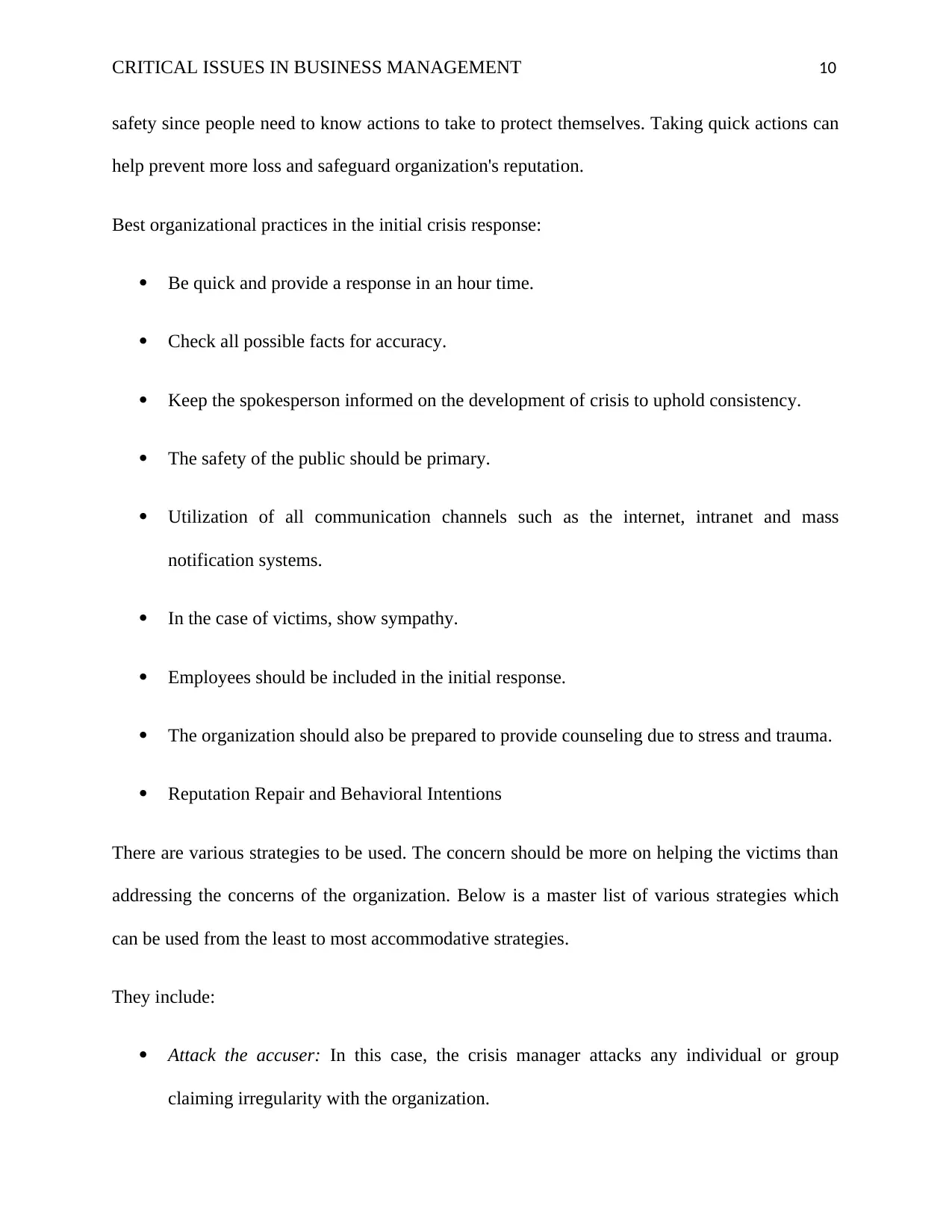
CRITICAL ISSUES IN BUSINESS MANAGEMENT 10
safety since people need to know actions to take to protect themselves. Taking quick actions can
help prevent more loss and safeguard organization's reputation.
Best organizational practices in the initial crisis response:
Be quick and provide a response in an hour time.
Check all possible facts for accuracy.
Keep the spokesperson informed on the development of crisis to uphold consistency.
The safety of the public should be primary.
Utilization of all communication channels such as the internet, intranet and mass
notification systems.
In the case of victims, show sympathy.
Employees should be included in the initial response.
The organization should also be prepared to provide counseling due to stress and trauma.
Reputation Repair and Behavioral Intentions
There are various strategies to be used. The concern should be more on helping the victims than
addressing the concerns of the organization. Below is a master list of various strategies which
can be used from the least to most accommodative strategies.
They include:
Attack the accuser: In this case, the crisis manager attacks any individual or group
claiming irregularity with the organization.
safety since people need to know actions to take to protect themselves. Taking quick actions can
help prevent more loss and safeguard organization's reputation.
Best organizational practices in the initial crisis response:
Be quick and provide a response in an hour time.
Check all possible facts for accuracy.
Keep the spokesperson informed on the development of crisis to uphold consistency.
The safety of the public should be primary.
Utilization of all communication channels such as the internet, intranet and mass
notification systems.
In the case of victims, show sympathy.
Employees should be included in the initial response.
The organization should also be prepared to provide counseling due to stress and trauma.
Reputation Repair and Behavioral Intentions
There are various strategies to be used. The concern should be more on helping the victims than
addressing the concerns of the organization. Below is a master list of various strategies which
can be used from the least to most accommodative strategies.
They include:
Attack the accuser: In this case, the crisis manager attacks any individual or group
claiming irregularity with the organization.
Secure Best Marks with AI Grader
Need help grading? Try our AI Grader for instant feedback on your assignments.
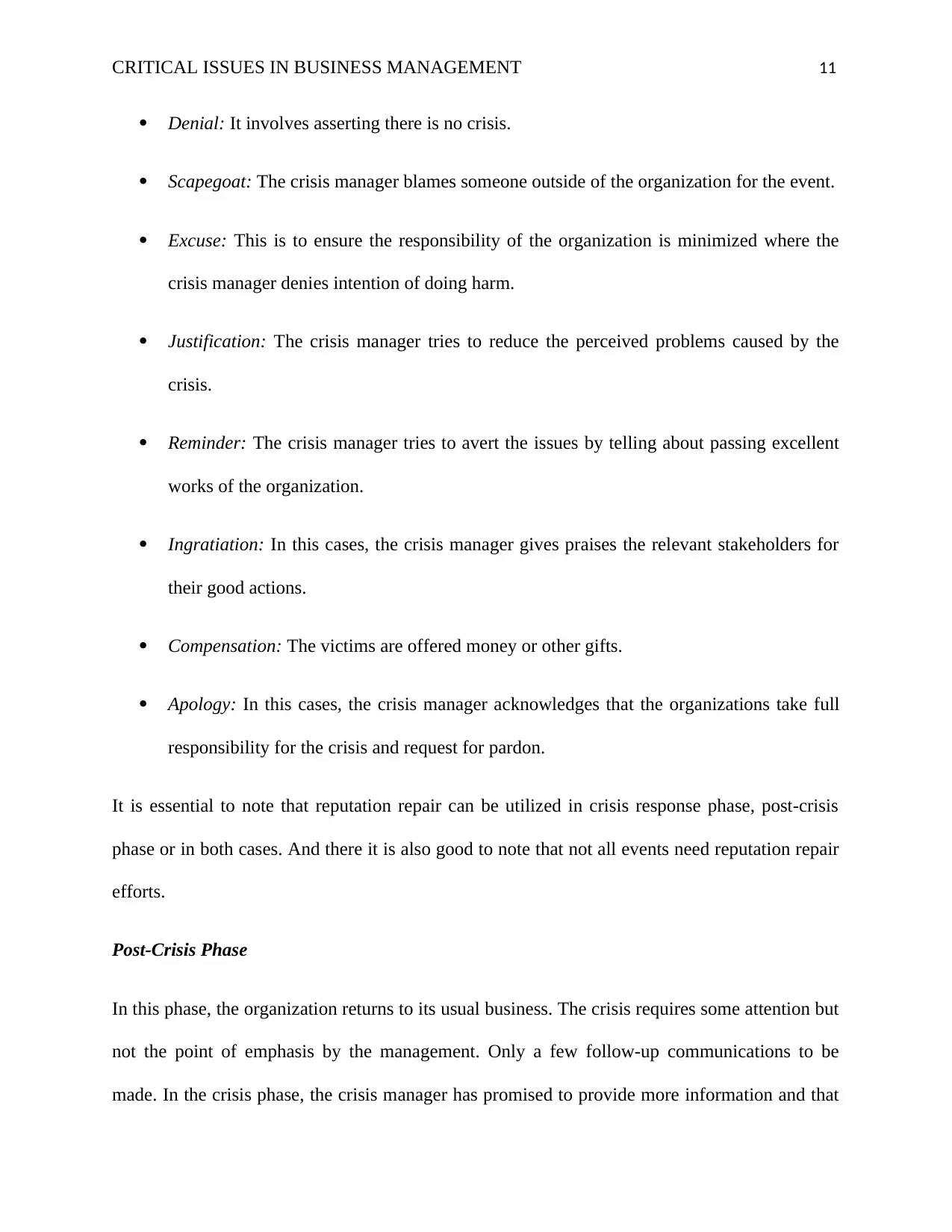
CRITICAL ISSUES IN BUSINESS MANAGEMENT 11
Denial: It involves asserting there is no crisis.
Scapegoat: The crisis manager blames someone outside of the organization for the event.
Excuse: This is to ensure the responsibility of the organization is minimized where the
crisis manager denies intention of doing harm.
Justification: The crisis manager tries to reduce the perceived problems caused by the
crisis.
Reminder: The crisis manager tries to avert the issues by telling about passing excellent
works of the organization.
Ingratiation: In this cases, the crisis manager gives praises the relevant stakeholders for
their good actions.
Compensation: The victims are offered money or other gifts.
Apology: In this cases, the crisis manager acknowledges that the organizations take full
responsibility for the crisis and request for pardon.
It is essential to note that reputation repair can be utilized in crisis response phase, post-crisis
phase or in both cases. And there it is also good to note that not all events need reputation repair
efforts.
Post-Crisis Phase
In this phase, the organization returns to its usual business. The crisis requires some attention but
not the point of emphasis by the management. Only a few follow-up communications to be
made. In the crisis phase, the crisis manager has promised to provide more information and that
Denial: It involves asserting there is no crisis.
Scapegoat: The crisis manager blames someone outside of the organization for the event.
Excuse: This is to ensure the responsibility of the organization is minimized where the
crisis manager denies intention of doing harm.
Justification: The crisis manager tries to reduce the perceived problems caused by the
crisis.
Reminder: The crisis manager tries to avert the issues by telling about passing excellent
works of the organization.
Ingratiation: In this cases, the crisis manager gives praises the relevant stakeholders for
their good actions.
Compensation: The victims are offered money or other gifts.
Apology: In this cases, the crisis manager acknowledges that the organizations take full
responsibility for the crisis and request for pardon.
It is essential to note that reputation repair can be utilized in crisis response phase, post-crisis
phase or in both cases. And there it is also good to note that not all events need reputation repair
efforts.
Post-Crisis Phase
In this phase, the organization returns to its usual business. The crisis requires some attention but
not the point of emphasis by the management. Only a few follow-up communications to be
made. In the crisis phase, the crisis manager has promised to provide more information and that
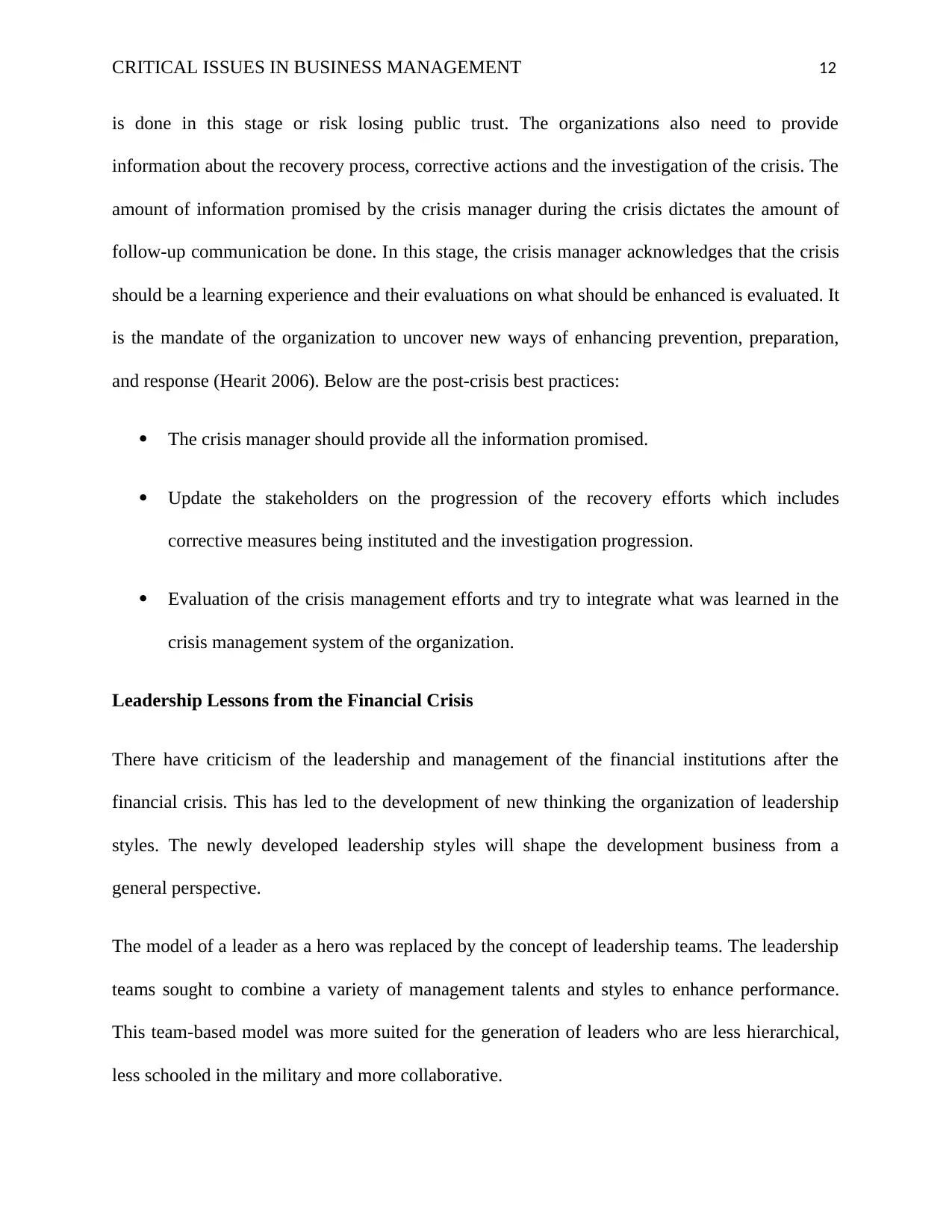
CRITICAL ISSUES IN BUSINESS MANAGEMENT 12
is done in this stage or risk losing public trust. The organizations also need to provide
information about the recovery process, corrective actions and the investigation of the crisis. The
amount of information promised by the crisis manager during the crisis dictates the amount of
follow-up communication be done. In this stage, the crisis manager acknowledges that the crisis
should be a learning experience and their evaluations on what should be enhanced is evaluated. It
is the mandate of the organization to uncover new ways of enhancing prevention, preparation,
and response (Hearit 2006). Below are the post-crisis best practices:
The crisis manager should provide all the information promised.
Update the stakeholders on the progression of the recovery efforts which includes
corrective measures being instituted and the investigation progression.
Evaluation of the crisis management efforts and try to integrate what was learned in the
crisis management system of the organization.
Leadership Lessons from the Financial Crisis
There have criticism of the leadership and management of the financial institutions after the
financial crisis. This has led to the development of new thinking the organization of leadership
styles. The newly developed leadership styles will shape the development business from a
general perspective.
The model of a leader as a hero was replaced by the concept of leadership teams. The leadership
teams sought to combine a variety of management talents and styles to enhance performance.
This team-based model was more suited for the generation of leaders who are less hierarchical,
less schooled in the military and more collaborative.
is done in this stage or risk losing public trust. The organizations also need to provide
information about the recovery process, corrective actions and the investigation of the crisis. The
amount of information promised by the crisis manager during the crisis dictates the amount of
follow-up communication be done. In this stage, the crisis manager acknowledges that the crisis
should be a learning experience and their evaluations on what should be enhanced is evaluated. It
is the mandate of the organization to uncover new ways of enhancing prevention, preparation,
and response (Hearit 2006). Below are the post-crisis best practices:
The crisis manager should provide all the information promised.
Update the stakeholders on the progression of the recovery efforts which includes
corrective measures being instituted and the investigation progression.
Evaluation of the crisis management efforts and try to integrate what was learned in the
crisis management system of the organization.
Leadership Lessons from the Financial Crisis
There have criticism of the leadership and management of the financial institutions after the
financial crisis. This has led to the development of new thinking the organization of leadership
styles. The newly developed leadership styles will shape the development business from a
general perspective.
The model of a leader as a hero was replaced by the concept of leadership teams. The leadership
teams sought to combine a variety of management talents and styles to enhance performance.
This team-based model was more suited for the generation of leaders who are less hierarchical,
less schooled in the military and more collaborative.
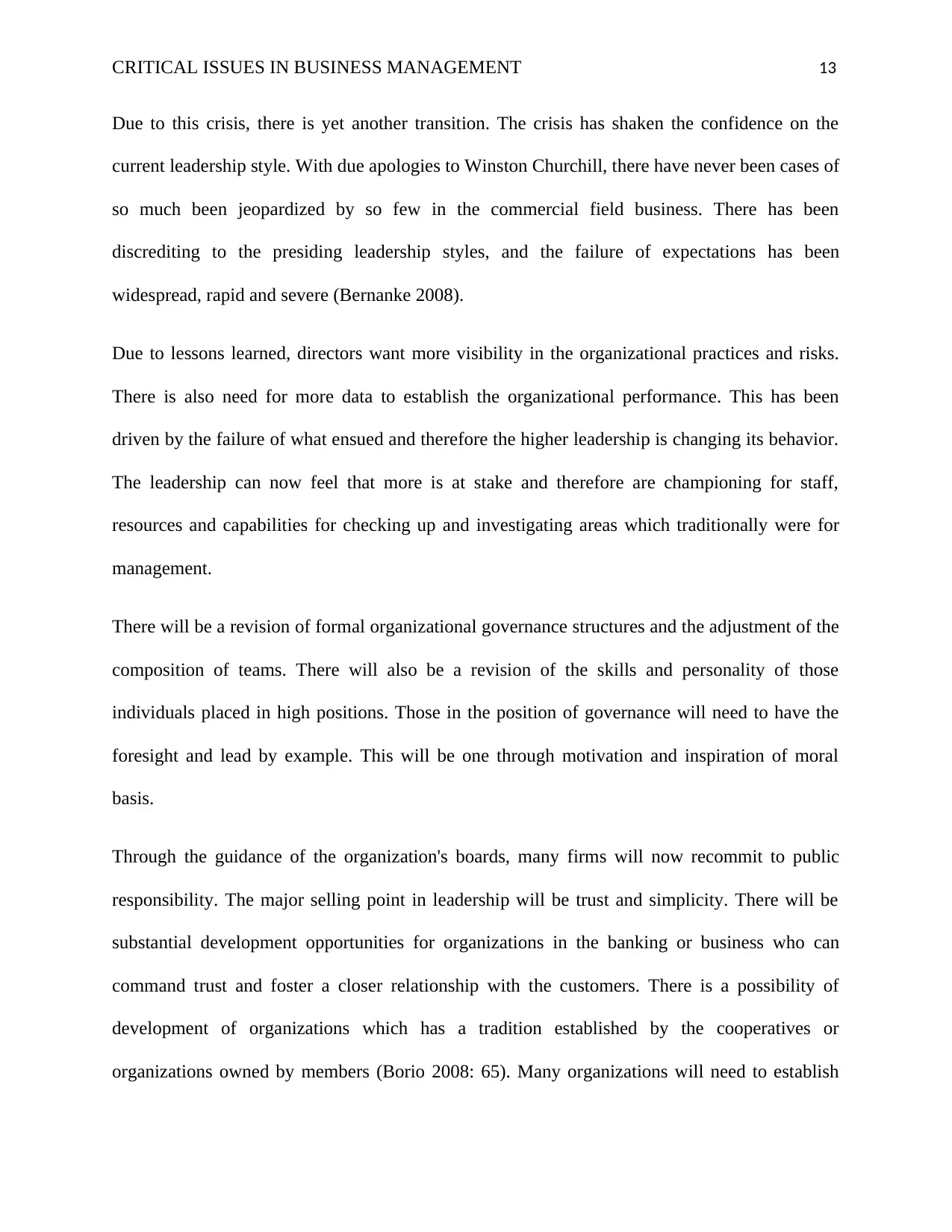
CRITICAL ISSUES IN BUSINESS MANAGEMENT 13
Due to this crisis, there is yet another transition. The crisis has shaken the confidence on the
current leadership style. With due apologies to Winston Churchill, there have never been cases of
so much been jeopardized by so few in the commercial field business. There has been
discrediting to the presiding leadership styles, and the failure of expectations has been
widespread, rapid and severe (Bernanke 2008).
Due to lessons learned, directors want more visibility in the organizational practices and risks.
There is also need for more data to establish the organizational performance. This has been
driven by the failure of what ensued and therefore the higher leadership is changing its behavior.
The leadership can now feel that more is at stake and therefore are championing for staff,
resources and capabilities for checking up and investigating areas which traditionally were for
management.
There will be a revision of formal organizational governance structures and the adjustment of the
composition of teams. There will also be a revision of the skills and personality of those
individuals placed in high positions. Those in the position of governance will need to have the
foresight and lead by example. This will be one through motivation and inspiration of moral
basis.
Through the guidance of the organization's boards, many firms will now recommit to public
responsibility. The major selling point in leadership will be trust and simplicity. There will be
substantial development opportunities for organizations in the banking or business who can
command trust and foster a closer relationship with the customers. There is a possibility of
development of organizations which has a tradition established by the cooperatives or
organizations owned by members (Borio 2008: 65). Many organizations will need to establish
Due to this crisis, there is yet another transition. The crisis has shaken the confidence on the
current leadership style. With due apologies to Winston Churchill, there have never been cases of
so much been jeopardized by so few in the commercial field business. There has been
discrediting to the presiding leadership styles, and the failure of expectations has been
widespread, rapid and severe (Bernanke 2008).
Due to lessons learned, directors want more visibility in the organizational practices and risks.
There is also need for more data to establish the organizational performance. This has been
driven by the failure of what ensued and therefore the higher leadership is changing its behavior.
The leadership can now feel that more is at stake and therefore are championing for staff,
resources and capabilities for checking up and investigating areas which traditionally were for
management.
There will be a revision of formal organizational governance structures and the adjustment of the
composition of teams. There will also be a revision of the skills and personality of those
individuals placed in high positions. Those in the position of governance will need to have the
foresight and lead by example. This will be one through motivation and inspiration of moral
basis.
Through the guidance of the organization's boards, many firms will now recommit to public
responsibility. The major selling point in leadership will be trust and simplicity. There will be
substantial development opportunities for organizations in the banking or business who can
command trust and foster a closer relationship with the customers. There is a possibility of
development of organizations which has a tradition established by the cooperatives or
organizations owned by members (Borio 2008: 65). Many organizations will need to establish
Paraphrase This Document
Need a fresh take? Get an instant paraphrase of this document with our AI Paraphraser
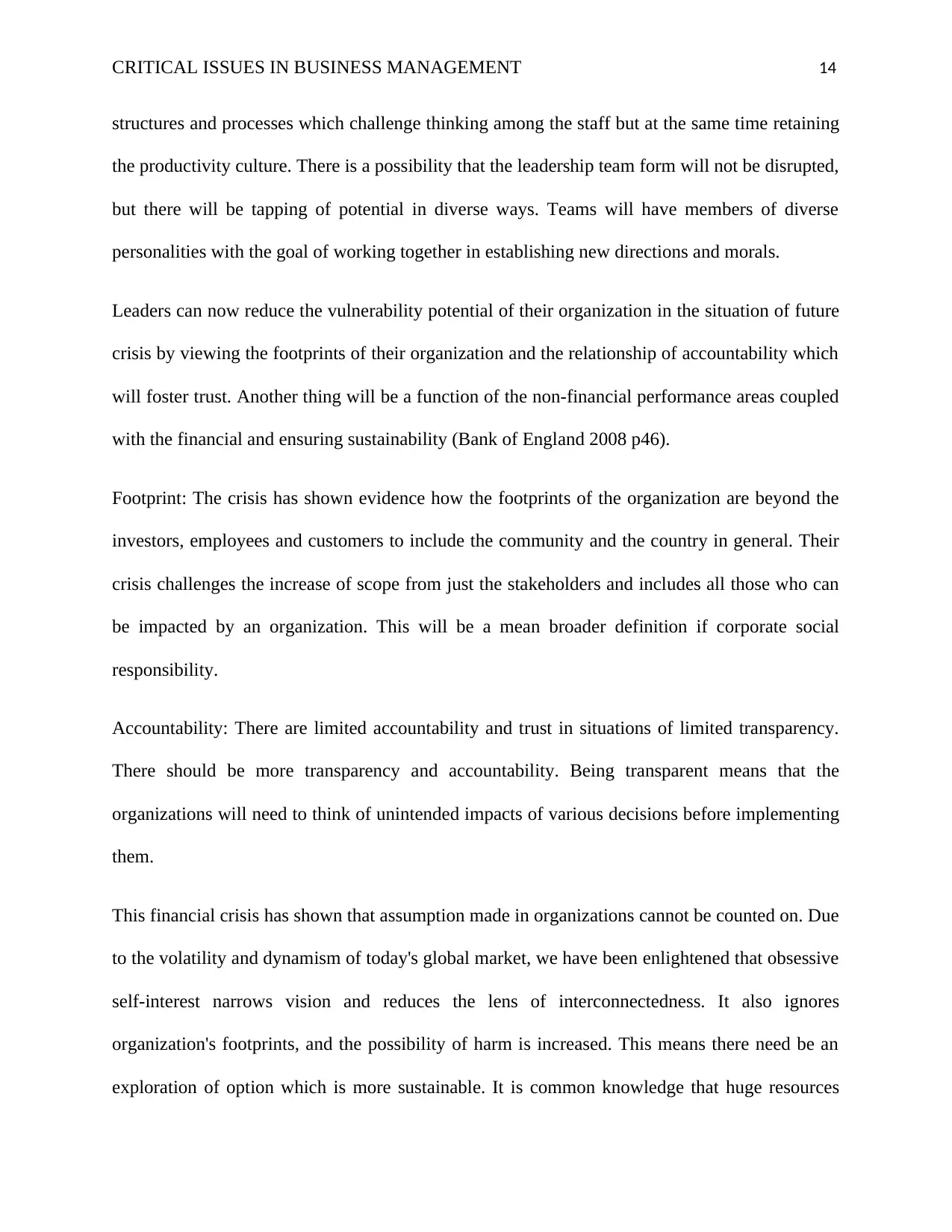
CRITICAL ISSUES IN BUSINESS MANAGEMENT 14
structures and processes which challenge thinking among the staff but at the same time retaining
the productivity culture. There is a possibility that the leadership team form will not be disrupted,
but there will be tapping of potential in diverse ways. Teams will have members of diverse
personalities with the goal of working together in establishing new directions and morals.
Leaders can now reduce the vulnerability potential of their organization in the situation of future
crisis by viewing the footprints of their organization and the relationship of accountability which
will foster trust. Another thing will be a function of the non-financial performance areas coupled
with the financial and ensuring sustainability (Bank of England 2008 p46).
Footprint: The crisis has shown evidence how the footprints of the organization are beyond the
investors, employees and customers to include the community and the country in general. Their
crisis challenges the increase of scope from just the stakeholders and includes all those who can
be impacted by an organization. This will be a mean broader definition if corporate social
responsibility.
Accountability: There are limited accountability and trust in situations of limited transparency.
There should be more transparency and accountability. Being transparent means that the
organizations will need to think of unintended impacts of various decisions before implementing
them.
This financial crisis has shown that assumption made in organizations cannot be counted on. Due
to the volatility and dynamism of today's global market, we have been enlightened that obsessive
self-interest narrows vision and reduces the lens of interconnectedness. It also ignores
organization's footprints, and the possibility of harm is increased. This means there need be an
exploration of option which is more sustainable. It is common knowledge that huge resources
structures and processes which challenge thinking among the staff but at the same time retaining
the productivity culture. There is a possibility that the leadership team form will not be disrupted,
but there will be tapping of potential in diverse ways. Teams will have members of diverse
personalities with the goal of working together in establishing new directions and morals.
Leaders can now reduce the vulnerability potential of their organization in the situation of future
crisis by viewing the footprints of their organization and the relationship of accountability which
will foster trust. Another thing will be a function of the non-financial performance areas coupled
with the financial and ensuring sustainability (Bank of England 2008 p46).
Footprint: The crisis has shown evidence how the footprints of the organization are beyond the
investors, employees and customers to include the community and the country in general. Their
crisis challenges the increase of scope from just the stakeholders and includes all those who can
be impacted by an organization. This will be a mean broader definition if corporate social
responsibility.
Accountability: There are limited accountability and trust in situations of limited transparency.
There should be more transparency and accountability. Being transparent means that the
organizations will need to think of unintended impacts of various decisions before implementing
them.
This financial crisis has shown that assumption made in organizations cannot be counted on. Due
to the volatility and dynamism of today's global market, we have been enlightened that obsessive
self-interest narrows vision and reduces the lens of interconnectedness. It also ignores
organization's footprints, and the possibility of harm is increased. This means there need be an
exploration of option which is more sustainable. It is common knowledge that huge resources
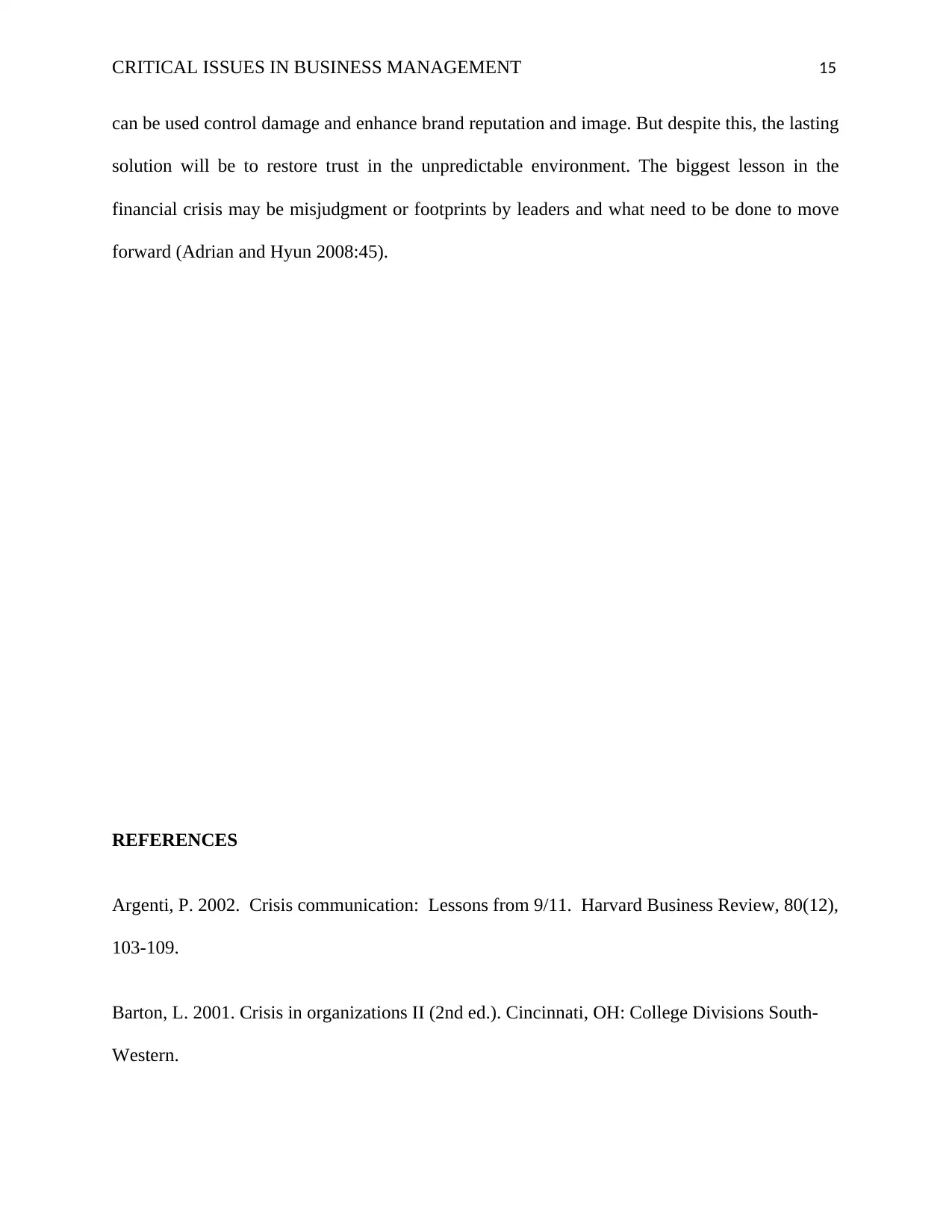
CRITICAL ISSUES IN BUSINESS MANAGEMENT 15
can be used control damage and enhance brand reputation and image. But despite this, the lasting
solution will be to restore trust in the unpredictable environment. The biggest lesson in the
financial crisis may be misjudgment or footprints by leaders and what need to be done to move
forward (Adrian and Hyun 2008:45).
REFERENCES
Argenti, P. 2002. Crisis communication: Lessons from 9/11. Harvard Business Review, 80(12),
103-109.
Barton, L. 2001. Crisis in organizations II (2nd ed.). Cincinnati, OH: College Divisions South-
Western.
can be used control damage and enhance brand reputation and image. But despite this, the lasting
solution will be to restore trust in the unpredictable environment. The biggest lesson in the
financial crisis may be misjudgment or footprints by leaders and what need to be done to move
forward (Adrian and Hyun 2008:45).
REFERENCES
Argenti, P. 2002. Crisis communication: Lessons from 9/11. Harvard Business Review, 80(12),
103-109.
Barton, L. 2001. Crisis in organizations II (2nd ed.). Cincinnati, OH: College Divisions South-
Western.
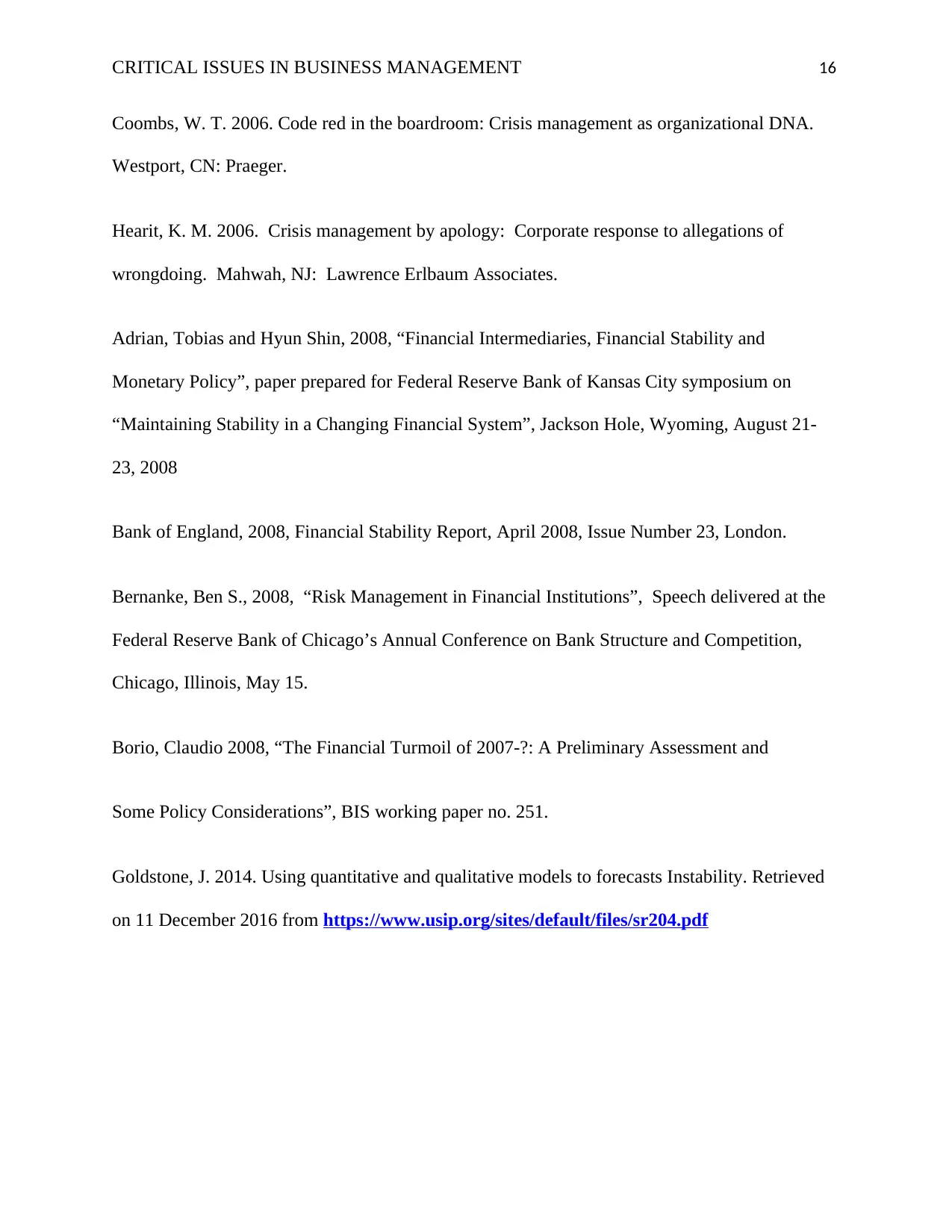
CRITICAL ISSUES IN BUSINESS MANAGEMENT 16
Coombs, W. T. 2006. Code red in the boardroom: Crisis management as organizational DNA.
Westport, CN: Praeger.
Hearit, K. M. 2006. Crisis management by apology: Corporate response to allegations of
wrongdoing. Mahwah, NJ: Lawrence Erlbaum Associates.
Adrian, Tobias and Hyun Shin, 2008, “Financial Intermediaries, Financial Stability and
Monetary Policy”, paper prepared for Federal Reserve Bank of Kansas City symposium on
“Maintaining Stability in a Changing Financial System”, Jackson Hole, Wyoming, August 21-
23, 2008
Bank of England, 2008, Financial Stability Report, April 2008, Issue Number 23, London.
Bernanke, Ben S., 2008, “Risk Management in Financial Institutions”, Speech delivered at the
Federal Reserve Bank of Chicago’s Annual Conference on Bank Structure and Competition,
Chicago, Illinois, May 15.
Borio, Claudio 2008, “The Financial Turmoil of 2007-?: A Preliminary Assessment and
Some Policy Considerations”, BIS working paper no. 251.
Goldstone, J. 2014. Using quantitative and qualitative models to forecasts Instability. Retrieved
on 11 December 2016 from https://www.usip.org/sites/default/files/sr204.pdf
Coombs, W. T. 2006. Code red in the boardroom: Crisis management as organizational DNA.
Westport, CN: Praeger.
Hearit, K. M. 2006. Crisis management by apology: Corporate response to allegations of
wrongdoing. Mahwah, NJ: Lawrence Erlbaum Associates.
Adrian, Tobias and Hyun Shin, 2008, “Financial Intermediaries, Financial Stability and
Monetary Policy”, paper prepared for Federal Reserve Bank of Kansas City symposium on
“Maintaining Stability in a Changing Financial System”, Jackson Hole, Wyoming, August 21-
23, 2008
Bank of England, 2008, Financial Stability Report, April 2008, Issue Number 23, London.
Bernanke, Ben S., 2008, “Risk Management in Financial Institutions”, Speech delivered at the
Federal Reserve Bank of Chicago’s Annual Conference on Bank Structure and Competition,
Chicago, Illinois, May 15.
Borio, Claudio 2008, “The Financial Turmoil of 2007-?: A Preliminary Assessment and
Some Policy Considerations”, BIS working paper no. 251.
Goldstone, J. 2014. Using quantitative and qualitative models to forecasts Instability. Retrieved
on 11 December 2016 from https://www.usip.org/sites/default/files/sr204.pdf
1 out of 16
Related Documents
Your All-in-One AI-Powered Toolkit for Academic Success.
+13062052269
info@desklib.com
Available 24*7 on WhatsApp / Email
![[object Object]](/_next/static/media/star-bottom.7253800d.svg)
Unlock your academic potential
© 2024 | Zucol Services PVT LTD | All rights reserved.





